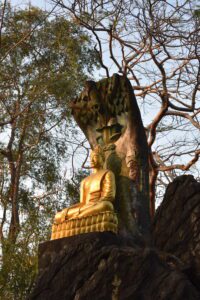Luang Prabang a UNESCO World Heritage Site
Luang Prabang is Laos’ most visited town and it’s easy to see why!
The old city is a recognized UNESCO World Heritage Site, chosen for both its architectural and artistic heritage in fusing traditional Lao and French colonial architecture. A great example of this is the building hosting today the National Museum, donated by the French government to the Kingdom of Laos.


Luang Prabang is considered the first capital of Laos in the 14th century. It then became a Siamese vassal state until the French defeated the Siamese in 1893 and established a protectorate. Under French protection, the Kingdom of Luang Prabang became the principal kingdom of French Laos. On 11 May 1947, the Kingdoms of Luang Prabang, Vientiane, and Champassak were reorganized into the Kingdom of Laos, with the King of Luang Prabang, Sisavang Vong, becoming King of Laos. In 1954, the Kingdom of Laos gained full independence from France.
Luang Prabang is particularly known for the morning alms giving, which is a longstanding Buddhist tradition where villagers cook and offer meals to the monks. This spiritual practice has become a major tourist attraction, which comes with disruptive consequences, such as people standing in the monks’ way to get ‘the perfect shot’, and sellers selling low-quality food to tourists to give to the monks… Not assisting felt more respectful.
A non-intrusive way to pay respect is to buy (or even better, to make) floral offerings, which are a familiar sight in Laos. Marigolds, the colour of monks’ robes, are the primary flower used as decoration of devotional flower offerings. Bonus, they smell super good!






Located in the middle of the city, Phousi Hill boasts what must be the best panoramic view of the region. Phousi hill has long been a temple, with Buddha images as well as monks’ living quarters.








As the sun sets, the night market comes to life. While the main part of the market is focused on local crafts and clothes, there is a food section where you can find all kinds of snacks and quick meals! (Stay away from the buffets – you don’t know how long that food’s been sitting there)
Lao cuisine shares similarities with Thai food but stands out with its bolder flavors, often leaning into intense sourness, bitterness, and spice. One of its most iconic dishes is larb, a minced meat salad that balances zesty lime, fresh herbs, and a hint of spice, with tofu being a delicious variation of this dish.
The omelette here is packed with bean sprouts, giving it a satisfying freshness and crunch. Fried spring rolls are crisp and perfectly golden, while kaipen, a unique Lao snack made from freshwater green algae, garlic, vegetables, and sesame seeds, offers a umami-packed bite. We also had sai oua, a fragrant Lao sausage full of herbs and spices. To end on a healthy note, morning glories are sold everywhere, our favorite greens ever since we first tried them in Taiwan.








The area around the town is known for its natural beauty as it is surrounded by mountains, forests, and rice patties.
One of the main attractions is the Kuang Si park.










Though Kuang Si park is primarily famous for its waterfall, the Tat Kuang Si Bear Rescue Centre is also located there. The Centre is home to rescued moon bears, victims of illegal wildlife trade, unable to be released into the wild and requiring lifelong care. The Australian organization Free The Bears seems to be hard at work, from providing a healthy habitat to dozens of animals, to performing the world’s first ever neurosurgery on a bear!
